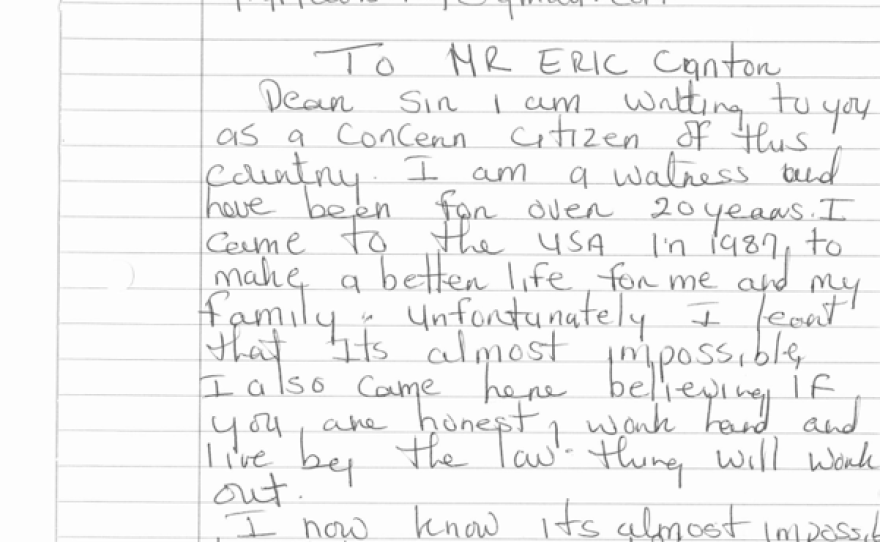Florida is among the top 10 states with the largest share of its population relying on food stamps. Nearly 20 percent of the state requires assistance. However, with federal cuts to the program likely, many could find it even more difficult in South Florida, where the cost of food is above the national average.
Just over a year ago, Miranda Childe was an assistant professor in English at Miami-Dade College. But due in part to funding cuts at state colleges, she suddenly found herself out of work.
Forced into early retirement, the 59-year-old from Hallandale was left with no salary and quickly vanishing savings.
Within a year, Childe was living at the federal poverty level. She and her roommate were awarded the maximum food stamp benefit in January - $365 in total per month. The average food stamp allotment is $133 per person or about $4 a day.
Childe had to forego the more healthy food she used to eat as a vegetarian and subsist on low-cost food.
“We certainly never go out to eat... we’re down to, like, Spam and spaghetti,” Childe said.
Spending Cuts Loom
And those benefits will likely become more scarce. The U.S. House of Representatives voted last week to cut five percent of funding for food stamps (nearly $4 billion annually) over the next 10 years. The Senate voted on a bill that would cut less - around $400 million a year.
Although the number of people on food stamps typically drops as the economy improves, in South Florida, the program actually grew between 2008 and 2012. Census Bureau data show that the percentage of eligible households in Broward and Miami-Dade doubled.
The cost of food is more in South Florida - about five percent higher than the rest of the nation, according to numbers from the Bureau of Labor Statistics.
Moreover, the cost of food is more in South Florida - about five percent higher than the rest of the nation, according to numbers from the Bureau of Labor Statistics.
The Economic Policy Institute estimates food expenses for a two-parent, one-child family in South Florida at about $600 a month. The average food stamp benefit of $133 per person would provide about $400 for a family of three.
Iris Montalvo, a Healthy Outreach program specialist at the Miami-Dade non-profit Regis House, said funding cuts would be “devastating” for her clients.
“I have clients right now that are complaining because they don’t get enough to help them throughout the month,” Montalvo said. “$133 doesn’t take you much anywhere - everything is up, and the salaries are not going up.”
In addition to cutting funds, the House bill would allow states to impose broader work requirements, permit drug testing for applicants and tighten eligibility standards for food stamps.
Montalvo said these new standards might exclude a lot of her clients, many of whom are immigrants without full status as citizens.
Making Ends Meet
Gloria Lewis tries to offer at least a temporary solution. Although her family is struggling to make ends meet, the waitress from Fort Lauderdale spends time and resources cooking free meals for the homeless, which she serves each weekend.
“I noticed that as we get closer to the end of the month, the line gets longer,” Lewis said. “Some of them get food stamps, and by the third week of the month they’re out of money.”
Lewis said she often cooks more than 100 meals, and still doesn’t have enough for all the people who show up.
“It’s just getting worse, it’s not getting better,” she said. “And unfortunately, it will get worse if they make these cuts.”
For Miranda Childe, things seemed to get better when she started receiving disability retirement benefits from the state.
But then, she was dropped from the food stamp program. Because of her disability income, Childe was no longer eligible to receive food stamps.
“The food stamps - when that disappeared, in June, since then, oh, it’s been so hard. It’s so hard.”
Without food stamps, Childe must now use her disability checks to cover both food and other costs like medications. Although Childe had hoped to reapply for food stamps in December, with cuts looming, she said she now fears that is just a pipe dream.
“Because of these cuts, I can’t even aspire to a whole life,” Childe said. “And I think other people in my situation may be even doing worse.”
This article includes comments from the Public Insight Network, an online community of people who have agreed to share their opinions with The Miami Herald and WLRN. Become a source at WLRN.org/insight.




